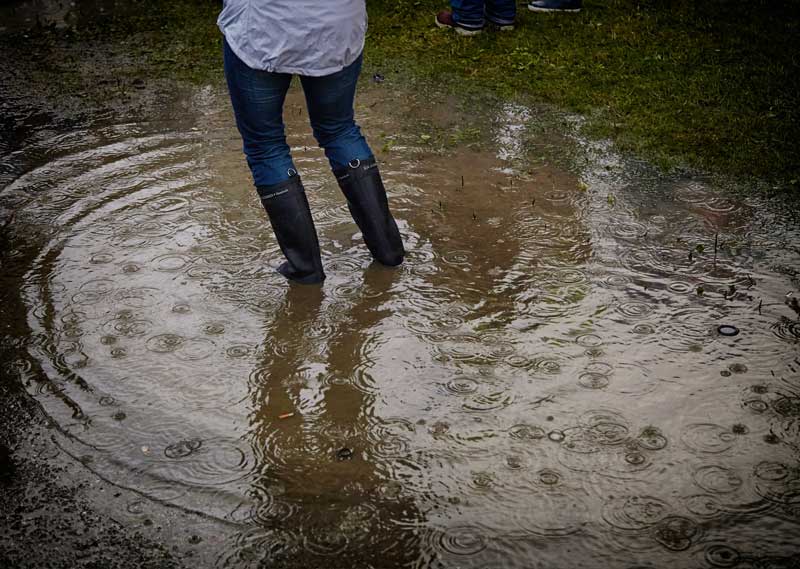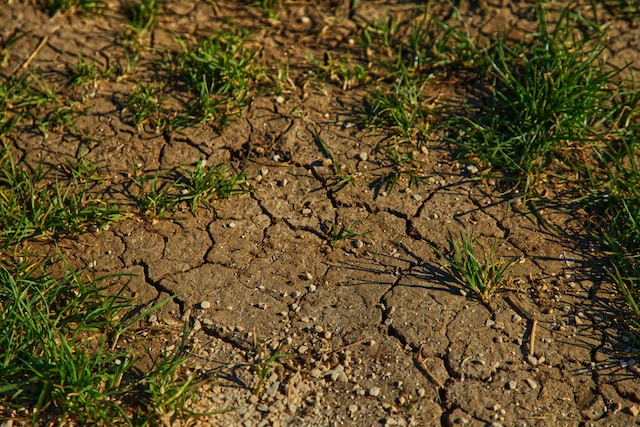If you’re reading this guide, you’ve likely experienced heavy rainfall, causing the soil to become waterlogged. Unfortunately, this is far from ideal as excessively wet soil can lead to drowning plant roots and create an unhealthy, swampy environment.
A garden with heavy clay soil can become compacted because the soil particles are too close together. A good indicator of this is when the soil becomes hard, dry and even cracked, which makes it difficult for water to pass through the earth. As a result, your clay soil garden becomes waterlogged. So, how do you fix this?
That’s where our guide comes in to advise you on how to deal with a waterlogged clay soil garden and offer some ideas for preventative measures for future events.
Table of contents:
How to improve waterlogged clay soil
Before we get started, these improvements will include drainage adjustments, so prepare to make a few changes.
Improvement number one: Aerate the compacted clay soil
You can use a garden fork (pitchfork) or hollow-tined aeration tool for this task (the latter removes soil plugs). Simply put, you’ll be poking holes in the soil to allow rainwater more space to flow down into the ground easily instead of causing puddles on the surface.

If choosing to aerate the soil, wait for the standing water to drain away. If the standing water is in small areas, sweep this away and off the lawn into the borders before starting your job. The holes should be between 10cm and 15cm (four inches to six inches) in size.
Tip: If you want to make your job easier or a little more fun, attachable lawn spikes that can connect to the bottom of your Wellington boot or garden shoes work as a temporary measure.
A powered aerator is more suited to bigger lawns (these can be bought or hired). Just ensure you sweep up and remove the soil plugs, then brush free-draining ‘top dressing’ (e.g., horticultural sand) into the holes.
Tip: If you have a lawn prone to waterlogging, spike it every few years during the autumn season to prevent the need for emergency work after a wet winter season.
Improvement number two: Take good care of your grass
You may cut and maintain grass with suitable clipping tools, but do you feed it?

Believe it or not, applying lawn feed in the spring can help the grass recover from waterlogging in the winter. It can also help improve the resilience of the roots.
It’s also a good idea to feed the lawn in autumn, but this lawn feed should be a fertiliser rich in phosphorus to promote root growth.
Improvement number three: Install a drainage system
Rich clays can make the soil very heavy, which is why it’s very common for them to become waterlogged across the whole garden. In this case, a drainage system (if possible) is your best approach to help guide and filter the water. Options are as follows, but they are not limited to:
- Soakaway
- A ditch
- Channel drainage
Realistically, an easy solution to excess water removal does not exist. If the problem is too much, a last resort is replacing the lawn altogether. This process is as follows:
Step one: Strip off the old turf.
Step two: Dig over the area.
Step three: Add enough organic matter (e.g., compost) to improve clay soil drainage.
Step four: Rake and level the surface.
Step five: Cover the new surface with a layer (minimum of five centimetres (two inches) of sharp sand.
Step six: (Choose one of two methods) Sow lawn seed or lay the new turf on top of the surface.
How to improve waterlogged soil – The short term
Short term, there are a few small things you can do to keep the issue from getting any worse.
Note: If possible, wait until the soil can be worked on to prevent compacting it and causing further problems.
Identify the cause of the excess water
Was it heavy rain, groundwater flooding, overflowing drains or something different? If you think the flooding is caused by overflowing drains outside the garden, contact your water company.
Clean and clear the area after the flooding
Wash down the hard surfaces and dispose of any debris (in and around the area) to prevent the following:
- Drains becoming clogged.
- Surfaces with soil being covered.
- Pollutants or contaminants lingering in the garden.
Deal with damaged clay soil plants and crops
Remove any damaged shoots from plants affected by the flooding and dispose of any edible crops near harvest. This is because there is no sure way to know if the root crops will be safe to consume after the flooding.
The Royal Horticultural Society (RHS) states any plants eaten in a raw state must also be disposed of. Unfortunately, it does mean that if you grow salads or other types of uncooked crops then this will have to be put on hold for at least two years. This is because disease spores can still sit in the soil.
With that said, crops that are to be cooked should be able to be grown safely a year after the flooding. If you’re unsure, have the soil tested before re-using it for crop and plant growth.
Apply feed and organic matter
The organic matter is to improve the soil structure. Alternatively, you can choose to apply a balanced fertiliser in the spring. Either way, ensure to mulch over the root area after application.
For feeding, choose foliar feeds during the growing season. This can help improve leaf colour and encourage new roots to grow.

Water the area after dry spells
The waterlogging will have affected your plants. As a result, they are more likely to suffer from drought stress. So, regular watering of the area after dry spells can help prevent this.

There you have it! Your steps for improving waterlogged clay soil. Now, if your garden has excessive water that needs draining, look no further than our guide to draining a flooded garden. There, you can find other reasons why your garden may flood, why improving lawn drainage is important and more. We also have a guide to improving your garden drainage for different types of gardens, so take a look there for more advice.







